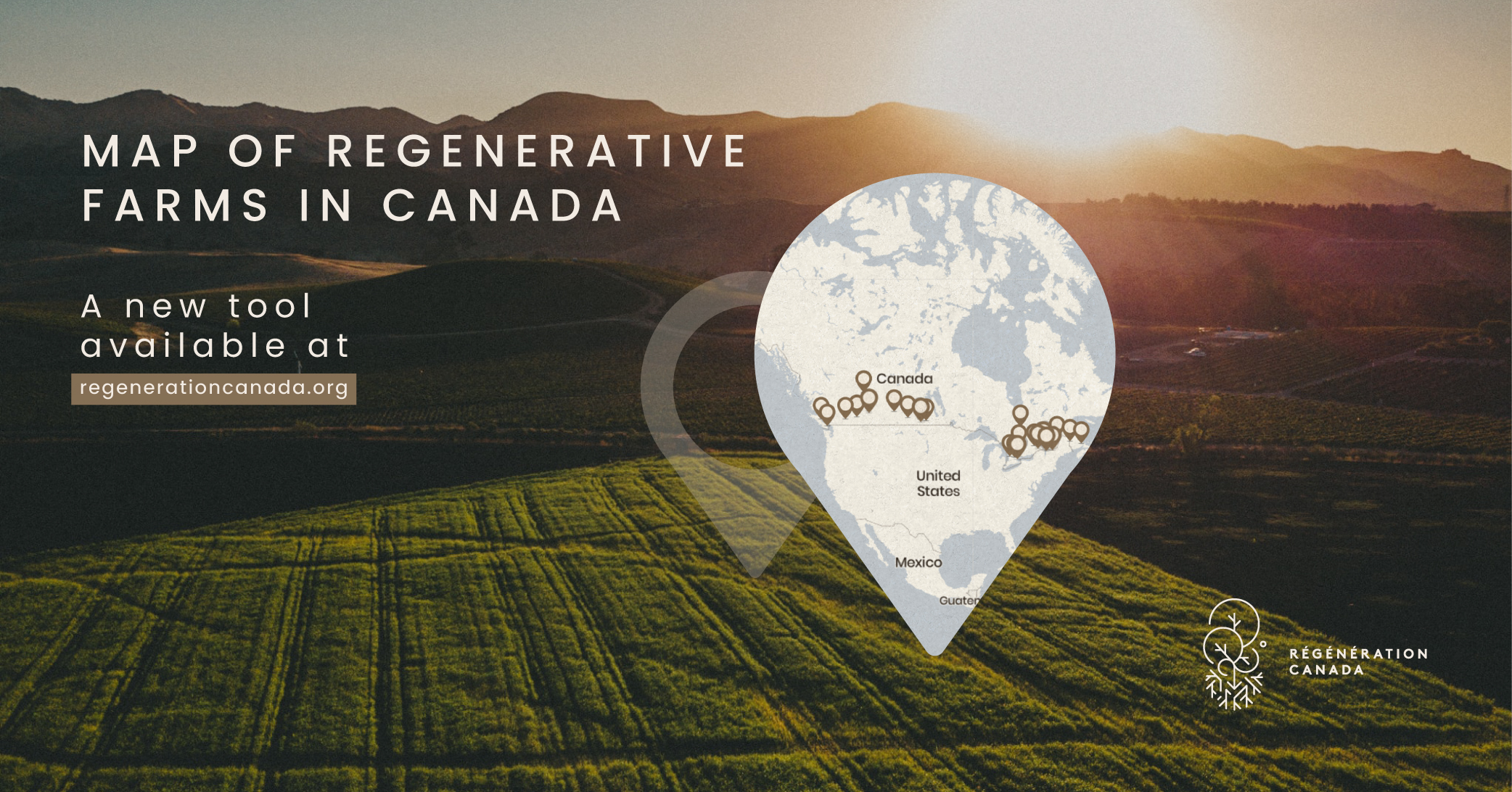Rolled Rye and Biodiversity as Drivers of Resilience
After Harvest, It’s Time to Reconnect
November brings a slower rhythm — the time to reconnect with those who’ve spent the season tending to their soil. This year, I had the pleasure of catching up with Sébastien Angers, agronomist and farmer at Ferme de l’Odyssée, in Nicolet, Quebec, over a video call to hear how the regenerative pumpkin seed plots I visited last year had evolved.

A leader in regenerative agriculture and a member of Regeneration Canada since our inception, Sébastien continues to innovate agronomically, both on his own farm and in collaboration with partner producers.
He also recently joined BIOSPHERES as an agronomist for Québec, an international regenerative agriculture initiative born in Europe that supports farmers and companies in impact measurement and agri-food systems transformation.
Sébastien serves as an agronomist for Quebec, adapting tools for measuring carbon, water, and biodiversity impacts, and tailoring regenerative performance monitoring frameworks to local soil and climate conditions.
An Extreme Season, a Stable Harvest: When Living Soil Makes the Difference
This summer brought its share of weather extremes: an overly wet spring followed by heat and drought. Despite everything, the pumpkin fields at Ferme de l’Odyssée and other partner producers still delivered a good harvest.
Yields remained steady at around 600 kg per hectare, which is impressive given the season’s volatility. For Sébastien, that stability isn’t luck — it’s the power of living soil. As he so aptly puts it, climate uncertainty is now part of the game; adaptation is no longer optional.
Working with farmers who have practiced no-till in diversified systems for over ten years, Sébastien has spent several seasons experimenting with different cover crop combinations to support regenerative pumpkin production. After many trials, rolled rye emerged as the strongest option for him.
The Agronomic Design of Rolled Rye
Sébastien describes rye as a smart ally — not just a cover crop, but a partner in design.
“In regenerative agriculture, you need to think of two crops to succeed with one. The pumpkin’s success depends first on the health of the rye.”

Sown the previous fall, rye protects the soil throughout the winter. It builds structure, improves porosity, retains moisture, and nourishes microbial life. When roller crimped in the spring, it becomes a dense carpet that keeps the soil cool, suppresses weeds, and feeds the underground ecosystem.
His approach is rooted in a logic of flow rather than quantity: understanding how nutrients move between rye biomass and pumpkin roots, and how soil life — worms, fungi, bacteria, nematodes — expresses itself.
The first instinct might be to fertilize the pumpkin directly. But Sébastien emphasizes the importance of feeding the cover crop, because that’s what drives the fertility cycle. Pumpkins need a lot of nitrogen—about 120 kg per hectare—but what matters most is when that nitrogen becomes available. To make sure nutrients are released at the right time for the pumpkins, he sometimes needs to fertilize the rye cover crop in the spring.
Sébastien explains that when rye is terminated in the spring, its roots start decomposing. This process requires energy from soil organisms, who temporarily draw down available nutrients from the soil. But pumpkins also need these nutrients to start growing strongly in their first three to four weeks. Balancing decomposition with nutrient availability can determine the success of the system.
And this balance between decomposition and nutrient availability seems to happen in other crops under rye mulch too. In the coming years, Sébastien plans to deepen his research on the relationships between necromass, dormant life, and active life in the soil.
An Open-Air Laboratory
Sébastien proudly pointed me to the new Pastel Fluo documentary, “Renouer avec la nature, semer la transition” (Reconnecting with Nature: Sowing the Transition). Among a cast of inspiring figures, we see Sébastien through the seasons, in his open-air laboratory — watching rye grow and harvesting pumpkins under the sky. The footage is magnificent!
He shares a simple phrase that captures his philosophy of reciprocity:
“I give, and I take.”

The rolled rye is there to give: feeding, protecting, and supporting biodiversity in the soil. Then comes the time to take, with the harvest of pumpkin seeds, followed by giving again, as all plant residues are returned to the field to close the nutrient cycle.
Hairy vetch is also part of this reciprocal design. Grown as an intercrop, this legume forms a symbiosis with rhizobium bacteria: the plant captures carbon from the air through photosynthesis and feeds the bacteria, which in return fix atmospheric nitrogen into the soil—helping create a more living, biologically active soil.
Biodiversity as a Compass
Biodiversity is a central principle of regenerative agriculture, and it lies at the heart of Sébastien’s approach. For him, it’s not just an indicator — it’s the system’s beating heart.
Across his fields and those of his partners, biodiversity expresses itself on multiple levels:
- Belowground, through the rich microbiome, with earthworms as architects and the roots of rye, vetch, and pumpkins as builders.
- At the surface, through rotations, cover crops, and a diversity of pumpkin varieties.
- Around the fields, through flower strips, hedgerows, and habitat for insects and birds that promote pollination.
“Resilience isn’t just about yield. It’s the foundation of business stability — and of psychological well-being for farmers.”
Each field becomes a link in a cooperative ecosystem, contributing to a necessary shift in how we define agricultural success.
A Regenerative Value Chain
The network around Sébastien continues to grow, with 46 hectares cultivated in 2025, four producers in full production and four others exploring new agronomic design, including two new participants.
Partnerships with Prana, Ferme Tournevent, and collaborating producers — including Fermes Clovis Gauthier, Bordelo, and JMDC — remain central:
- Prana for marketing the delicious, regeneratively grown pumpkin seeds (I honestly can’t live without them anymore!)
- Ferme Tournevent for processing the seeds into locally-produced pumpkin seed oil
- and the producer partners for carrying out applied agronomic research.

New local cleaning and drying facilities now allow seed processing directly on-site — a significant step toward a fully regenerative value chain, from soil to shelf.
For Sébastien, success lies in quality relationships, not just transactional ones.
Toward 2026: A Vision Taking Root
Looking ahead, Sébastien plans to add a second harvester, expand to 75–80 hectares, and open new markets in Canada and the U.S.
But beyond numbers and markets, each conversation with him is a powerful reminder of the importance of refocusing on life, creativity, and humanity at the core of our systems.
Through his pumpkins and his dreams, Sébastien reminds us that to regenerate is not merely to produce — it is to find our place in the cycle of life.
Resources for Producers
If you’re a farmer interested in hosting a production or research plot on your farm, reach out directly to Sébastien Angers.
Curious to explore rolled rye, cover cropping, and other regenerative practices? Explore our Toolbox for regeneration — a hub of practical, farmer-focused resources to support you in adopting regenerative principles on your farm.




